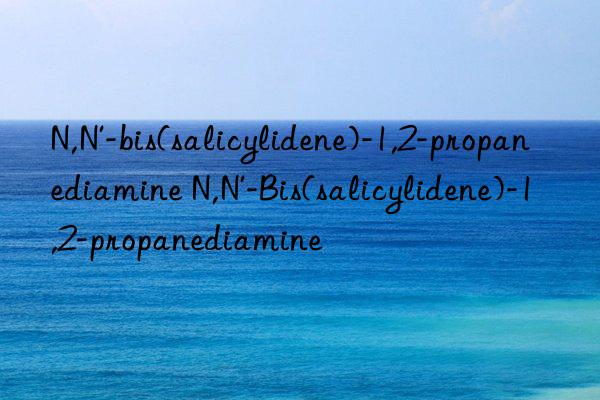
Structural formula
| Business number | 028B |
|---|---|
| Molecular formula | C17H18N2O2 |
| Molecular weight | 282.34 |
| label | N,N'-Disalicylic aldehyde acetyl-1,2-propanediamine, N,N'-bisalicylin-1,2-propanediamine, N,N'-Bis(o-hydroxybenzylidene)-1,2-diaminopropane |
Numbering system
CAS number:94-91-7
MDL number:None
EINECS number:None
RTECS number:None
BRN number:None
PubChem ID:None
Physical property data
1. Properties: yellow oily liquid.
2. Density (g/mL, 20℃): Undetermined
3. Relative vapor density (g/mL, air=1): Undetermined
4. Melting point (ºC): 48
5. Boiling point (ºC, normal pressure): Undetermined
6. Boiling point (ºC, mmHg): Undetermined
7. Refractive index: Undetermined
8. Flash point (ºC): Undetermined
9. Specific rotation (º): Undetermined
10. Autoignition point or ignition temperature (ºC): Undetermined
11. Vapor pressure (mmHg, ºC): Undetermined
12. Saturated vapor pressure (kPa , ºC): Undetermined
13. Heat of combustion (KJ/mol): Undetermined
14. Critical temperature (ºC): Undetermined
15 . Critical pressure (KPa): Undetermined
16. Log value of oil-water (octanol/water) distribution coefficient: Undetermined
17. Explosion upper limit (%, V/V ): Undetermined
18. Lower explosion limit (%, V/V): Undetermined
19. Solubility: Miscible with ethanol and benzene, soluble in toluene and diamine Toluene and gasoline are insoluble in water.
Toxicological data
1. Acute toxicity: Rat oral LD50: 4560mg/kg;
Ecological data
None
Molecular structure data
1. Molar refractive index: 83.42
2. Molar volume (cm3/mol): 252.3
3. Isotonic specific volume (90.2K ): 644.4
4. Surface tension (dyne/cm): 42.5
5. Polarizability (10-24cm3): 33.07
Compute chemical data
1. Hydrophobic parameter calculation reference value (XlogP): 3.9
2. Number of hydrogen bond donors: 2
3. Number of hydrogen bond acceptors: 4
4. Number of rotatable chemical bonds: 5
5. Number of tautomers: 9
6. Topological molecular polar surface area (TPSA): 58.2
p>7. Number of heavy atoms: 21
8. Surface charge: 0
9. Complexity: 604
10. Number of isotope atoms : 0
11. The number of determined atomic stereocenters: 0
12. The number of uncertain atomic stereocenters: 1
13. DeterminedNumber of stereocenters of chemical bonds: 2
14. Number of stereocenters of uncertain chemical bonds: 0
15. Number of covalent bond units: 1
Properties and stability
None
Storage method
None
Synthesis method
None
Purpose
Metal passivators have two applications in the oil refining industry. (1) Substances used to inhibit the catalytic effect of active metal ions (copper, iron, nickel, manganese, etc.) on oil oxidation. It is often used in combination with antioxidants in light fuels such as gasoline, jet fuel, and diesel to improve the stability of oil products and extend the storage period. Commonly used ones include N,N'-disalicylidenepropanediamine. (2) In the catalytic cracking of heavy oil, antimony compounds are commonly used as substances used to inhibit the influence of heavy metals (nickel, vanadium, copper, etc.) contained in the oil on the catalyst activity.

 微信扫一扫打赏
微信扫一扫打赏

